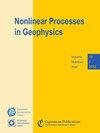A global analysis of the fractal properties of clouds revealing anisotropy of turbulence across scales
IF 1.7
4区 地球科学
Q3 GEOSCIENCES, MULTIDISCIPLINARY
引用次数: 0
Abstract
Abstract. The deterministic motions of clouds and turbulence, despite their chaotic nature, nonetheless follow simple statistical power-law scalings: a fractal dimension D relates individual cloud perimeters p to measurement resolution, and turbulent fluctuations scale with separation distance through the Hurst exponent ℌ. It remains uncertain whether atmospheric turbulence is best characterized by split isotropy that is three-dimensional with ℌ = 1/3 at small scales and two-dimensional with ℌ = 1 at large scales, or by wide-range anisotropic scaling with an intermediate value of ℌ. Here, we introduce an “ensemble fractal dimension” De – analogous to D – that relates the total cloud perimeter per domain area 𝒫 as seen from space to measurement resolution, and show theoretically how turbulent dimensionality and cloud edge geometry are linked through ℌ =De − 1. Observationally, by progressively coarsening the resolution of cloud mask arrays from various global satellite platforms and a numerical simulation of a tropical domain we find the scaling De ~ 5/3, or ℌ ~ 2/3, a value nearly consistent with a previously proposed “23/9D” anisotropic turbulent scaling. Remarkably, the same scaling links two “limiting case” estimates of 𝒫 evaluated at the planetary scale and the Kolmogorov microscale, as separated by 11 orders of magnitude, suggesting that cloud and turbulent behaviors are constrained by basic planetary parameters.对云的分形特性进行全球分析,揭示不同尺度湍流的各向异性
摘要云和湍流的确定性运动尽管具有混沌性质,但却遵循简单的统计幂律标度:分形维数 D 将单个云的周长 p 与测量分辨率联系起来,而湍流波动则通过赫斯特指数ℌ随分离距离而缩放。目前仍不确定的是,大气湍流的最佳特征是分裂各向同性,即小尺度上为ℌ = 1/3 的三维分裂各向同性和大尺度上为ℌ = 1 的二维分裂各向同性,还是具有中间值ℌ 的广域各向异性缩放。在这里,我们引入了一个 "集合分形维度 "De(类似于 D),它将从空间到测量分辨率所看到的每个域面积 𝒫 的总云周长联系起来,并从理论上说明了湍流维度和云边缘几何是如何通过 ℌ =De - 1 联系起来的。通过逐步提高各种全球卫星平台云掩模阵列的分辨率和对热带域的数值模拟观测,我们发现 De ~ 5/3 或 ℌ ~ 2/3 的缩放比例,该值与之前提出的 "23/9D "各向异性湍流缩放比例几乎一致。值得注意的是,同样的缩放比例将在行星尺度和科尔莫哥罗德微尺度上评估的𝒫的两个 "极限情况 "估计值联系在一起,两者相差 11 个数量级,这表明云和湍流行为受到基本行星参数的制约。
本文章由计算机程序翻译,如有差异,请以英文原文为准。
求助全文
约1分钟内获得全文
求助全文
来源期刊

Nonlinear Processes in Geophysics
地学-地球化学与地球物理
CiteScore
4.00
自引率
0.00%
发文量
21
审稿时长
6-12 weeks
期刊介绍:
Nonlinear Processes in Geophysics (NPG) is an international, inter-/trans-disciplinary, non-profit journal devoted to breaking the deadlocks often faced by standard approaches in Earth and space sciences. It therefore solicits disruptive and innovative concepts and methodologies, as well as original applications of these to address the ubiquitous complexity in geoscience systems, and in interacting social and biological systems. Such systems are nonlinear, with responses strongly non-proportional to perturbations, and show an associated extreme variability across scales.
 求助内容:
求助内容: 应助结果提醒方式:
应助结果提醒方式:


